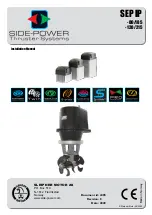
Quick Start Guide
AD9125-EBZ
©2010 Analog Devices, Inc. All rights reserved. Trademarks and
registered trademarks are the property of their respective owners.
D00000-0-1/07(A)
JUMPER CONFIGURATIONS
There are 7 pin jumpers and 13 solder jumpers on the evaluation board. The pin jumpers are corresponding to the 6 supplies, i.e., AVDD3.3,
DVDD1.8, CVDD1.8 and etc, on the board. They serve as ‘switches’ that determine if the LDOs on board or external supplies are used for
each individual supply. Most of the pin jumpers, except JP1, are 2 pin jumpers. They are shunted by default,
which means on board LDOs are used. When an external supply is necessary, pull off the shunt from the corresponding supply and connect
the external supply to the SMA jack close to the jumper. JP1 should be left in the default configuration.
Solder jumpers JP4, 5, 6, and 17 determine whether the DAC outputs go to the SMA connectors or to the modulator inputs. When direct
DAC outputs are to be monitored, JP4, 5, 6, and 17 should be configured as what Figure 1 shows. When the modulator output is to be
measured, they should be configured as what Figure 2 shows.
Figure 1: DAC Output Configuration
Figure 2: Modulator Output Configuration
The solder jumper on the left side of C139 determines whether the ref/sync clock of the AD9125 is from the AD9516 or an external source
through the SMA jack J14 (AD9125_REF_CLKIN). When the AD9516 is used for the clock source, the jumper should be configured so
that the center pad is connected to the top pad. When an external source is used, the center pad should be connected to the bottom pad.
Other solder jumpers should be left in the default configuration.
GETTING STARTED – SINGLE TONE TEST
It is suggested that the basic set-up is verified before making any modifications to the evaluation board. This can be done with either ACE,
the preferred evaluation software, or the SPI GUI. Use the modulator output jumper configuration for the single tone test. Other
configuration outputs are also in the “Results” section.




























